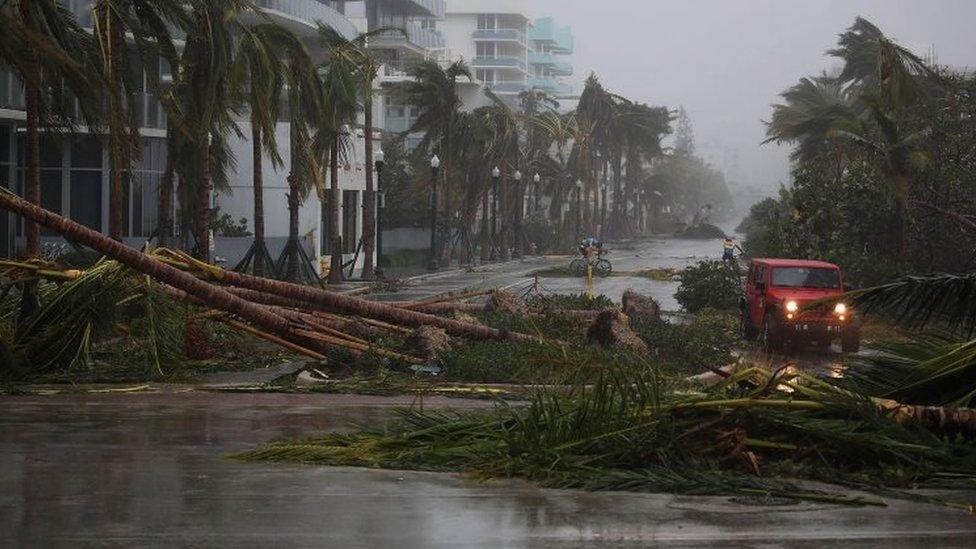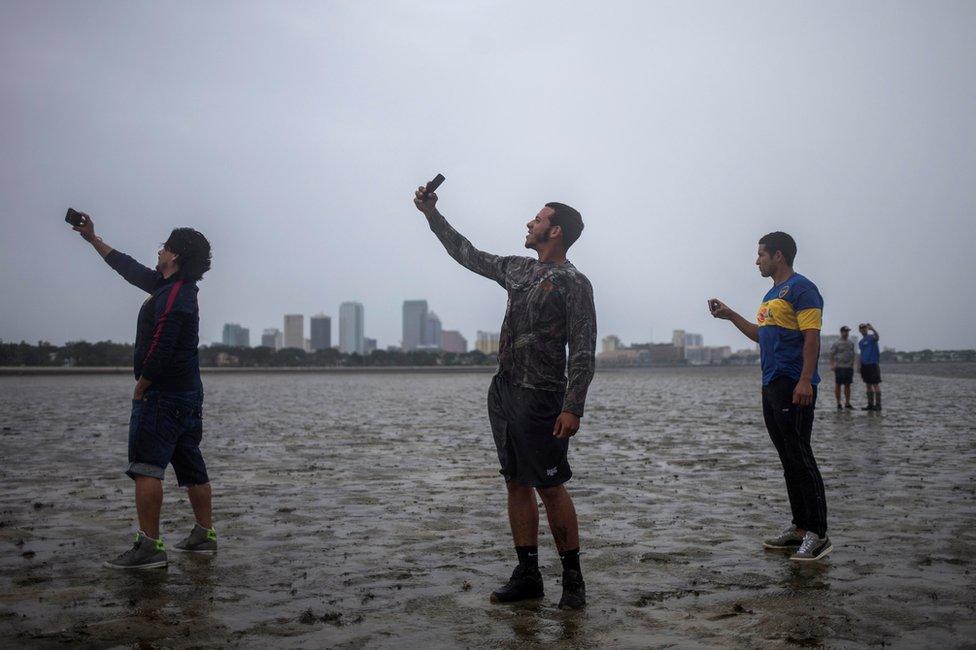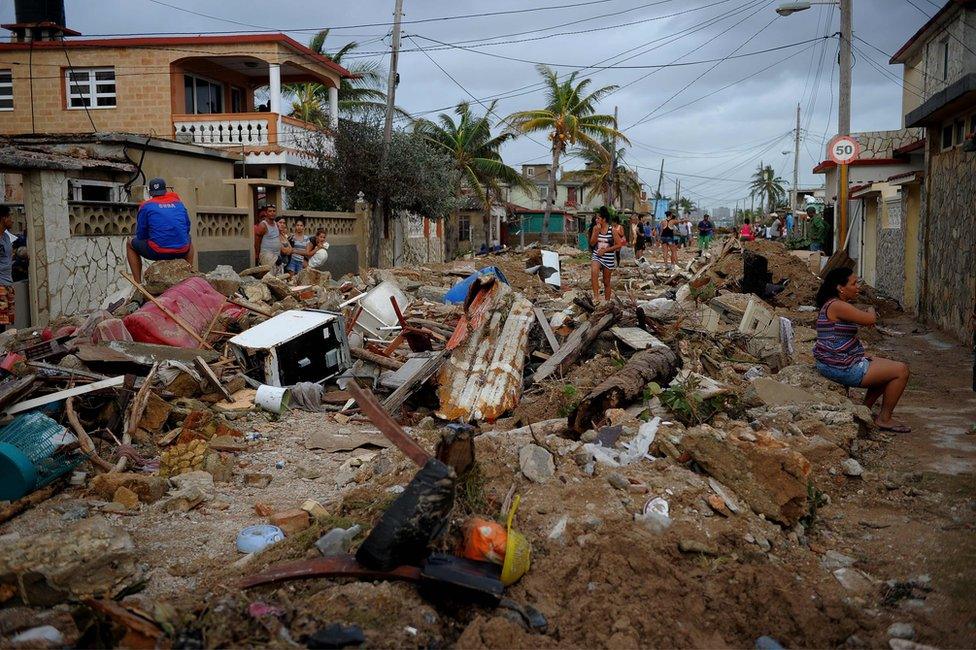Hurricane Irma: Storm hits west coast of Florida
- Published
Strong winds and rain have been battering Florida
Hurricane Irma is blasting up the west coast of Florida after buffeting the city of Miami, with dangerous flooding along long stretches of coast.
It has been downgraded from category three to one but still has maximum sustained winds of 75mph (120km/h).
More than 3.4 million homes in the state are without power, with parts of the city of Miami under water.
At least four deaths have been linked to the storm and several areas have brought in curfews.
Are you in the region? Have you been affected by Hurricane Irma? If it is safe for you to do so, share your experiences by emailing haveyoursay@bbc.co.uk, external.
Florida's Director of Emergency Management, Bryan Koon, said late in Sunday he could not yet confirm or deny reports of multiple deaths and extensive damage.
Search and rescue efforts are due to begin on Monday morning, he said.
Irma cut a devastating track across 10 Caribbean countries and territories, killing at least 28 people there.
President Donald Trump has approved a major disaster declaration and emergency federal aid for Florida, describing the hurricane as a "big monster".
Irma continues to affect Florida
Where is the storm now?
At 09:00 GMT, the centre of the hurricane was about 60 miles (100km) north of Tampa, the National Hurricane Center (NHC) said, external.
Some 3m people live in the Tampa Bay area. The region has not been hit by a major hurricane since 1921.
Irma is expected to weaken into a tropical storm over far northern Florida or southern Georgia later on Monday but first its centre will continue to move over the western Florida peninsula, the NHC said.

A vehicle passes downed palm trees in Miami

These Tampa residents were out taking photos on Sunday as the storm strengthened
Storm surge warnings are in effect for:
The South Santee river southward to Jupiter Inlet
Cape Sable northward to the Ochlockonee river
Tampa Bay
How did it arrive in Florida?
Irma made landfall on Marco Island off Florida's west coast at 15:35 local time (19:35 GMT) on Sunday, with winds of up to 120mph.
After leaving the coast of Cuba, Irma had barrelled through the Florida Keys, a chain of low-lying islands to the south, on Sunday morning.

The whole of the southern tip of Florida has seen high winds, driving rain and storm surges.
About 2ft of water has been seen in Miami's financial district, where one major street resembled a river, but the worst damage is expected on the west coast. Two cranes have collapsed in high winds in the city.
How have residents felt the impact?
At least four deaths have been connected to the storm:
A police officer working at a hurricane shelter in Hardee County was killed driving home when she collided with another vehicle being driven by a fellow officer, who also died
A person died in a single-car crash in Orange County
A man died in Marathon, Monroe County, on Saturday when his truck hit a tree, the sheriff's office said, adding that it was unknown if the crash had been weather-related or not
Some 6.3 million people in the state were told to evacuate before the storm.
Watch: Amateur footage shows flooding in central Miami
As many as 4.4 million homes and businesses have lost power, Reuters news agency reports, quoting Florida Power & Light and other utilities.
There is major disruption to transport, with Fort Lauderdale-Hollywood International Airport and Miami International Airport closed for Monday.
Amid fears of debris and reports of looting, curfews have been imposed in areas such as Miami-Dade County.
Which other areas have already been hit?
Irma is the most powerful Atlantic storm in a decade, and has already caused widespread destruction on several Caribbean islands:
Cuba: Officials have talked of "significant damage", without giving further details, but no casualties have been reported. Electricity is out across the capital, Havana
St Martin and St Barthelemy: Six out of 10 homes on St Martin, an island shared between France and the Netherlands, are now uninhabitable, French officials say. They said nine people had died and seven were missing in the French territories, while four are known to have died in Dutch Sint Maarten

Damage in Havana from Hurricane Irma
Turks and Caicos Islands: Widespread damage, although extent unclear
Barbuda: The small island is said to be "barely habitable", with 95% of the buildings damaged. Antigua and Barbuda Prime Minister Gaston Browne estimates reconstruction will cost $100m (£80m). One death has been confirmed
Anguilla: Extensive damage with one person confirmed dead
Puerto Rico: More than 6,000 residents of the US territory are in shelters and many more without power. At least three people have died
British Virgin Islands: Widespread damage reported, and five dead
US Virgin Islands: Damage to infrastructure was said to be widespread, with four deaths confirmed
Haiti and the Dominican Republic: Both battered by the storm, but neither had as much damage as initially feared
Another hurricane, Jose, has been weakening over the western Atlantic, external, with swells due to affect parts of Hispaniola (the island split into Haiti and the Dominican Republic), the Bahamas, and the Turks and Caicos Islands, over the next couple of days.


Are you in the region? Are you a holidaymaker unable to get a flight home or a resident who has been preparing for Hurricane Irma? If it is safe for you to do so, share your experiences by emailing haveyoursay@bbc.co.uk, external.
Please include a contact number if you are willing to speak to a BBC journalist. You can also contact us in the following ways:
WhatsApp: +447555 173285
Tweet: @BBC_HaveYourSay, external
Send pictures/video to yourpics@bbc.co.uk, external
Upload your pictures / video here, external
Send an SMS or MMS to 61124 or +44 7624 800 100
Please read our terms & conditions